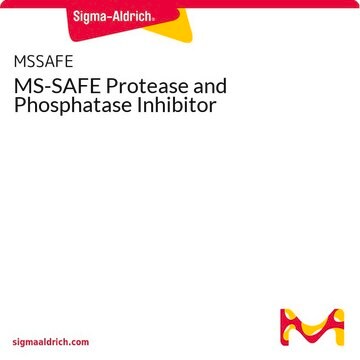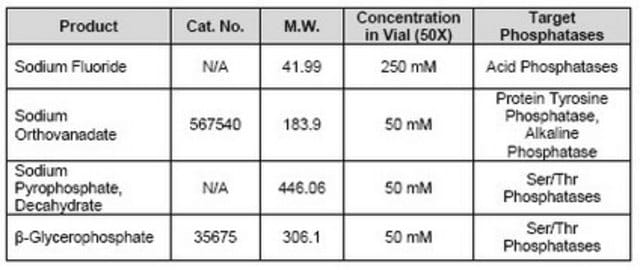PPC1010
Protease and Phosphatase Inhibitor Cocktail
DMSO solution, for the inhibition of serine, cysteine, acid proteases, aminopeptidase, serine/threonine protein phosphatases and L-isozymes of alkaline phosphatase
Synonyme(s) :
Protease and Phosphatase Inhibitor Mix, Protease and phosphatase inhibitor
About This Item
Produits recommandés
product name
Protease and Phosphatase Inhibitor Cocktail,
Forme
DMSO solution
Niveau de qualité
Conditionnement
pkg of 1 ml, 5 ml ×
Conditions d'expédition
wet ice
Température de stockage
−20°C
Catégories apparentées
Description générale
Application
- for cellular protein extraction
- to lyse purified CD4+ T cells
- to prepare protein extracts from placental tissues and cells
Notes préparatoires
Autres remarques
Mention d'avertissement
Warning
Mentions de danger
Conseils de prudence
Classification des risques
Eye Irrit. 2 - Skin Irrit. 2
Code de la classe de stockage
10 - Combustible liquids
Classe de danger pour l'eau (WGK)
WGK 2
Point d'éclair (°F)
188.6 °F
Point d'éclair (°C)
87 °C
Certificats d'analyse (COA)
Recherchez un Certificats d'analyse (COA) en saisissant le numéro de lot du produit. Les numéros de lot figurent sur l'étiquette du produit après les mots "Lot" ou "Batch".
Déjà en possession de ce produit ?
Retrouvez la documentation relative aux produits que vous avez récemment achetés dans la Bibliothèque de documents.
Les clients ont également consulté
Contenu apparenté
Panorama des méthodes de lyse cellulaire et d'extraction protéique, comme la solubilisation par détergents, la lyse par congélation/décongélation, le choc osmotique, la sonication, la lyse cellulaire enzymatique et les techniques de fragmentation mécanique comme l'homogénéisation au Dounce, au Polytron ou au mortier et au pilon.
Cell lysis and protein extraction methods overview various techniques, from detergent solubilization to mechanical disruption, supporting research needs.
Notre équipe de scientifiques dispose d'une expérience dans tous les secteurs de la recherche, notamment en sciences de la vie, science des matériaux, synthèse chimique, chromatographie, analyse et dans de nombreux autres domaines..
Contacter notre Service technique
















